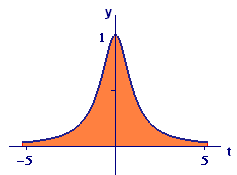Chapter 9
Probability and Integration
9.2 Improper Integrals
9.2.4 More Improper Integrals
Just as we can integrate to `oo`, we can integrate to `-oo` and, for some functions, even from `-oo` to `oo`.
| Definitions If `g text[(] t text[)]` is a continuous function for `t ≤ a`, then the improper integral
If the limiting value exists as a finite number, we say the improper integral converges. Otherwise, it diverges. If `g text[(] t text[)]` is a continuous function for all `t` then the improper integral If both integrals on the right converge, we say the improper integral on the left converges. Otherwise, it diverges. |
Example 5
Show that the area under the graph of `y = 1/(1 + t^2)` is `pi` (see Figure 3).

Solution The shaded area is
The choice of `t = 0` as a dividing point between the left-hand and right-hand improper integrals is merely a matter of convenience, not of necessity — see Exercise 11. However, actually splitting the two-sided improper integral into two one-sided improper integrals is, in general, necessary for getting right answers — see Exercise 12 for an example in which failing to split gives a wrong answer. For the function in Example 5, we could have used symmetry to evaluate the integral as twice the integral from `0` to `oo` — see Exercise 13.


